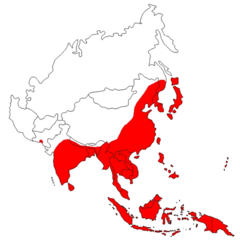Definition
Japanese encephalitis is an infection of the brain caused by a virus. The virus is transmitted to humans by mosquitoes.
Description
The virus that causes Japanese encephalitis is called an arbovirus, which is an arthropod-borne virus. Mosquitoes are a type of arthropod. Mosquitoes in a number of regions carry this virus and are responsible for passing it along to humans. Many of these areas are in Asia, including Japan, Korea, China, India, Thailand, Indonesia, Malaysia, Vietnam, Taiwan, and the Philippines. Areas where the disease-causing arbovirus is always present are referred to as being endemic for the disease. In such areas, blood tests will reveal that more than 70% of all adults have been infected at some point with the arbovirus.
Because the virus that causes Japanese encephalitis is carried by mosquitoes, the number of people infected increases during those seasons when mosquitoes are abundant. This tends to be in the warmest, rainiest months. In addition to humans, other animals like wild birds, pigs, and horses are susceptible to infection with this arbovirus. Because the specific type of mosquito carrying the Japanese encephalitis arbovirus frequently breeds in rice paddies, the disease is considered to be primarily a rural problem.
Causes & symptoms
The virus is transferred to a human when an infected mosquito sucks that person's blood. Once in the body, the virus travels to various glands where it multiplies. The virus can then enter the bloodstream. Ultimately, the virus settles in the brain, where it causes serious problems.
Japanese encephalitis begins with fever, severe headache, nausea, and vomiting. As the tissue covering the brain and spinal cord (the meninges) becomes infected and swollen, the patient will develop a stiff and painful neck. By day two or three, the patient begins to suffer the effects of swelling in the brain. These effects include:
- Problems with balance and coordination
- Paralysis of some muscle groups
- Tremors
- Seizures
- Lapses in consciousness
- A stiff, mask-like appearance of the face.
The patient becomes dehydrated and loses weight. If the patient survives the illness, the fever will decrease by about day seven and the symptoms will begin to improve by about day 14. Other patients will continue to have extremely high fevers and their symptoms will get worse. In these cases, coma and then death occur in 7-14 days. Many patients who recover have permanent disabilities due to brain damage.
Diagnosis
Most diagnostic techniques for Japanese encephalitis do not yield results very quickly. The diagnosis is made primarily on the basis of the patient's symptoms and the knowledge of the kinds of illnesses endemic to a particular geographic region.
Immunofluorescence tests, where special viral markers react with human antibodies that have been tagged with a fluorescent chemical, are used to verify the disease. However, these results tend to be unavailable until week two of the infection. Other tests involve comparing the presence and quantity of particular antibodies in the blood or spinal fluid during week one with those present during week two of the illness.
Treatment
There are no treatments available to stop or slow the progression of Japanese encephalitis. Only the symptoms of each patient can be treated. Fluids are given to decrease dehydration and medications are given to decrease fever and pain. Medications are available to attempt to decrease brain swelling. Patients in a coma may require mechanical assistance with breathing.
Prognosis
While the majority of people infected with arbovirus never become sick, those who develop Japanese encephalitis become very ill. Some outbreaks have a 50% death rate. A variety of long-term problems may haunt those who recover from the illness. These problems include:
- Movement difficulties where the arms, legs, or body jerks or writhes involuntarily
- Shaking
- Paralysis
- Inability to control emotions
- Loss of mental abilities
- Mental disturbances, including schizophrenia (which may affect as many as 75% of Japanese encephalitis survivors).
Young children are most likely to have serious, long-term problems after an infection.
Prevention
A three-dose vaccine is available for Japanese encephalitis and is commonly given to young children in areas where the disease is endemic. Travelers to these regions can also receive the vaccine.
Controlling the mosquito population with insecticides is another preventive measure. Visitors to regions with high rates of Japanese encephalitis should take precautions (like using mosquito repellents and sleeping under a bed net) to avoid contact with mosquitoes.
Key Terms
- Antibody
- A type of cell made by the immune system that has the ability to recognize markers (antigens) on the surface of invading organisms, like bacteria and viruses.
- Encephalitis
- A swelling of the brain, potentially causing serious brain damage.
- Endemic
- Naturally and consistently present in a certain geographical region.
Further Reading
For Your Information
Books
- Douglas, R. Gordon. "Other Arthropod-Borne Viruses." In Cecil Textbook of Medicine, edited by J. Claude Bennett and Fred Plum. Philadelphia: W. B. Saunders, 1996.
- Ray, C. George. "Arthropod-Borne and Other Zoonotic Viruses." In Sherris Medical Microbiology: An Introduction to Infectious Diseases, edited by Kenneth J. Ryan. Norwalk, CT: Appleton & Lange, 1994.
Organizations
- Centers for Disease Control and Prevention. (404) 332-4559. http://www.cdc.gov/travel/travel.html.
Gale Encyclopedia of Medicine. Gale Research, 1999.



